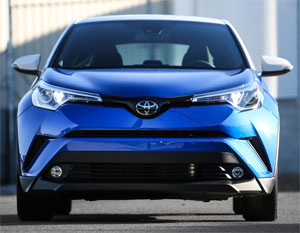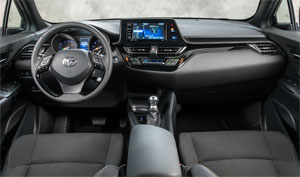2018 Toyota C-HR
The upside of the Scion brand’s demise is that things are getting a little more exciting at corporate parent Toyota. This re-branded C-HR, or coupe high rider, gives Toyota a much-needed entry into the subcompact utility category, and one with looks that are quite out there. But, does C-HR also deliver meaningful utility, or is it all about funky style?
First things first, the 2018 Toyota C-HR does indeed give Toyota another entry into what is the fastest growing vehicle choice today, utility vehicles. It slides under the Rav4 in their car-based crossover lineup. First revealed in concept form at the 2014 Paris Motor Show, the CH-R also indicates a bolder direction in overall Toyota design.
The production model clearly resembles that concept, but is far from an exact copy. The front end sets a very confident tone; while deep-cut body lines point towards the C-pillars, where there’s both a floating roof design and high-mounted door handles.
From there, an almost horizontal back glass leads to a hacked-off rear with its own aggressive lines. Wheelbase is less than an inch shorter than the RAV4, yet there’s over a foot difference in overall length. 18-inch alloys and 50-Series tires are standard.
 There are plenty of aero treatments that the kid’s love these days, including diffuser, spoiler, wheel spats, and even “vortex generators”.
There are plenty of aero treatments that the kid’s love these days, including diffuser, spoiler, wheel spats, and even “vortex generators”.
Those high-mounted door handles actually work great. But, do yourself a favor and skip the white roof option; unless you’re going for the taxicab look.
No all-wheel-drive for now, front-wheel-drive only. No factory turbo either, as those front wheels get power from a naturally aspirated 2.0-liter I4 good for 144–horsepower and 139 lb-ft. of torque. Toyota is leaving it to the aftermarket to add more.
Unfortunately, it’s CVT only for tranny duties.
But not so fast; that CVT does a good job of delivering the moderate power smoothly, and CVT-induced engine noise is relatively minor here, as is noise in general.
It’s also has a very solid feeling for a small ute, riding on the Toyota Prius’ recently updated New Global Architecture chassis. Handling is quite good, as it remains very flat in corners, urging you to push it harder than you probably should; though there’s not enough power here for you to really get yourself into too much trouble.
Through the rolling Hill Country around Austin, Texas, we found steering to be very quick, with good feedback through the wheel, as well as through the brake pedal.
 Things are very sporty in both look and feel inside, with a hip Scion-like touchscreen audio display, but no Satellite radio, Apple CarPlay, or Android Auto.
Things are very sporty in both look and feel inside, with a hip Scion-like touchscreen audio display, but no Satellite radio, Apple CarPlay, or Android Auto.
Likewise, gauges are more Scion than Toyota; with a 4.2-inch TFT multi-instrument display that gives lots of info including a G-Force monitor.
Front seat space is plentiful and are sufficiently comfortable. All controls are within easy reach. Rear seats are claustrophobic. Not a lot of space, and very little window to see out of; though there are belts for 3 back here.
Like many sub-compact crossovers, cargo space is just adequate; 19.0 cubic-ft. puts it slightly under the Honda HR-V, but much higher than the Mazda CX-3. Folding the seatbacks takes it to more acceptable 36.4 cubic-ft.
Now, as for what this Coupe High Rider crossover is not; well, despite its slick shape, it’s not a coupe, more of a 5-door hatchback. And it doesn’t ride overly high either, with just 5.9-inches of ground clearance. And it’s certainly not a traditional crossover without all-wheel-drive. So what’s left? A lot of target marketing and a respectable amount of fun.
 No skimping on safety features however. Toyota’s unfortunately-named Safety Sense P, with Pre-Collision System and Full-Speed Range Dynamic Radar Cruise Control, is standard, as are 10-airbags.
No skimping on safety features however. Toyota’s unfortunately-named Safety Sense P, with Pre-Collision System and Full-Speed Range Dynamic Radar Cruise Control, is standard, as are 10-airbags.
Government Fuel Economy Ratings are 27-City, 31-Highway, and 29-Combined. For a better than average Energy Impact Score of 11.4-barrels of yearly oil use with 5.0-tons of CO2 emitted.
As for the sticker prices? Base XLE trim starts at $23,460; XLE Premium, at $25,310. That puts it above the Mazda3, Honda HR-V, and Nissan Juke; however, both models are very well equipped, and without options to hike that price up further.
In today’s “multi-culti” world, where we try to combine the best attributes of all cultures; the 2018 Toyota C-HR tries to put crossover practicality into a conglomeration with youthful style and peppy performance; and for the most part succeeds very well.
But still, it’s a form over function piece that much like the Nissan Juke, will appeal mostly to city-dwelling urban adventurers who need an easy to park ride with more flexibility than the typical compact. But, even without all-wheel-drive, that may be enough to give the Scion faithful an easy entry into the “Mother Brand” and make this high ridin’ coupe a hit for Toyota.
Specifications
- Engine: 2.0 liter
- Horsepower: 144
- Torque: 139 lb-ft.
- EPA: 27 mpg city / 31 mpg highway
- Energy Impact: 11.4 barrels of oil/yr
- CO2 Emissions: 5.0 tons/yr
2024 Toyota Land Cruiser
Toyota’s Go Anywhere Globetrotter Returns To U.S.
Every once in a while, we all need a reset. A time to get back to basics and prioritize the things that really matter. Well, for the Toyota Land Cruiser that time is now. So, let’s find out if that means bigger and better things for Toyota’s iconic off-roader.
The Toyota Land Cruiser’s status among the global off-road community is legendary, and it’s hard to imagine there’s any corner of the earth where a Land Cruiser hasn’t kicked up a little dust or mud. Well, 2024 sees the return of the Land Cruiser to the U.S. market after a 3-year hiatus, getting a major reset for the journey.
The reset comes mostly by no longer being based on the large three-row “300-series” chassis, but a new version of the smaller “200-series,” now known as the J250. As with the latest Tacoma, it uses the Tundra pickup’s full-size steel frame.
While the main Land Cruiser model, which goes by simply Land Cruiser, is packed full of luxury and convenience features, there is also a stripped-down model known as the 1958, honoring the first year the Land Cruiser made landfall here in North America. And it is that 1958 we have here, and we were glad to see it, as it also celebrates the original’s back-to-basics approach as a blank canvas for you to personalize as you tackle more and more adventures.
Not that it’s fully stripped down, as 8-inch touchscreen infotainment, a 7-inch full-color multi-information display, and automatic climate control are still standard. Plus, some seriously durable materials, and great heated cloth front seats that throw off some get serious 1990s Tacoma vibes.
But outside, there’s a definite lack of flashy trim and basic looking 18-inch wheels with Yokohama Geolander all-season tires; plus, big chunky bumpers and tilt-up back glass, which is a rarity that we appreciate. Though there is a little too much plastic in places that are sure to see some abuse if you do any significant off-roading.
It even feels a little rough around the edges, but for us it just adds to the rugged old-school utility vibe in a good way.
We did just that, both here in the Mid-Atlantic as well as in the California desert; and while there are some tech-forward driving aids, the actual hardware is in most cases plenty to get things done. That includes standard full-time dual-range four-wheel-drive, locking center and rear diffs, and 8.7-inches of ground clearance. A front stabilizer bar disconnect is also available to allow for increased articulation.
Who needs a V6 or even a V8 when you’ve got Toyota’s i-FORCE MAX setup at your disposal with 326 horsepower and 465 lb-ft of torque coming from a 2.4-liter turbo-four with an electric motor sandwiched between the engine and its eight-speed automatic transmission. Low speed torque delivery is impressive. It even feels a little rough around the edges, which may be a turn off to some, but for us it just adds to the rugged old-school utility vibe in a good way.
And it certainly feels quicker than an off roader needs to be, with an instant torque dump as soon as we eased on the throttle at our Mason Dixon test track; helping us get to 60 in 8.1 seconds and through the quarter-mile in 16.3 seconds at 86 mph. Considering the Land Cruiser’s terrain conquering mission, it behaved quite well in our handling course; it was plenty responsive to inputs, with less body roll than we expected and plenty of grip from the tires. The steering was light and quick but as expected didn’t provide much feel. Other than significant nosedive, braking performance was exceptional. Only 107-feet to panic stop us from 60 mph.
With the shift to the smaller size, there’s no more third row available, and cargo capacity now comes in at 46.2 cubic-feet with a max of a still healthy 82.1. Now, the best part of the Land Cruiser’s return is the entry price of $57,445. That’s about 30-grand less than what the last Land Cruiser went for back in 2021.
Whether it’s over the top fashion trends, mullets, or zombies; just when you think they’re dead, they come roaring back to life. Of course, we’re much happier to see the resurrection of this 2024 Toyota Land Cruiser than any of those things. Toyota is one brand that still recognizes the value of full-framed rugged rigs and has also acknowledged that sometimes less really is more. The Godfather of Toyota off-roading is back and better than ever.







